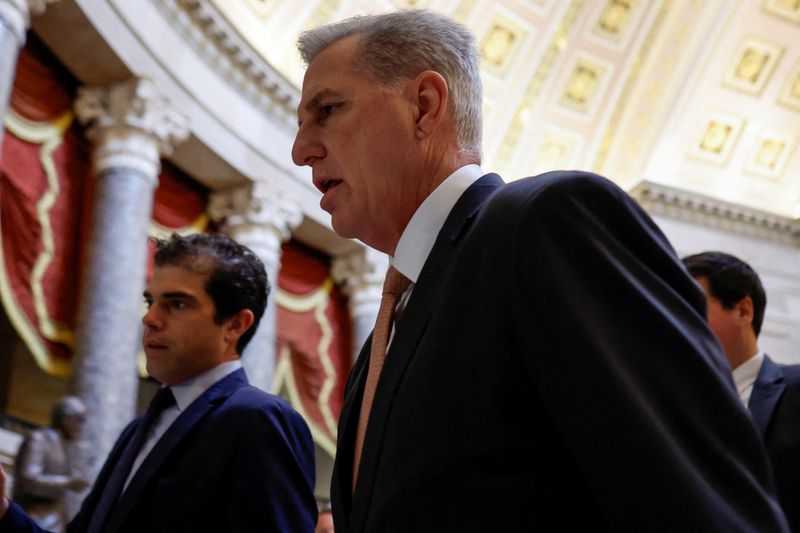U.S. House Republicans chart new strategy to pressure Biden, Democrats
2023.04.16 06:34
2/2

© Reuters. FILE PHOTO: U.S. House Speaker Kevin McCarthy (R-CA) walks to his offices at the U.S. Capitol in Washington, U.S. February 27, 2023. REUTERS/Jonathan Ernst/File Photo
2/2
By David Morgan
WASHINGTON (Reuters) – U.S. House Republicans will try to agree on a plan to lift the federal $31.4 trillion debt ceiling and cut government spending when Congress returns this week, after being stymied for months by Democratic President Joe Biden’s demands they do so without conditions.
House of Representatives Speaker Kevin McCarthy in a Monday speech at the New York Stock Exchange will lay out the conditions Republicans want Democrats to agree to in exchange for movement on the debt ceiling.
He has offered few specific details ahead of the talk, but Republicans have proposed holding annual spending growth to 1% for a decade, reducing regulation and boosting energy production.
Members of McCarthy’s sometimes-fractious caucus, who hold a narrow 222-213 majority, have yet to agree on actual legislation. Any proposal Republicans introduce would need to be negotiated with Biden’s Democrats, who control the Senate, before it could become law.
The White House, which is leading the Democrats’ approach to the debt ceiling, has dismissed the Republican proposals as unrealistic.
Nonpartisan forecasters have warned the federal government could face a historic default this summer if Congress fails to act. A default could cripple the U.S. and world economies and force a downgrade of the U.S. credit rating, as occurred in a 2011 standoff over the debt.
But McCarthy’s speech, which Republicans say is intended to draw Wall Street’s support for negotiations on spending, could spark movement after months of inaction. Biden has insisted that Congress pass a “clean” debt hike without conditions, noting that it did so three times under his predecessor, Republican Donald Trump.
“At this point, I think there’s no choice for Republicans and the speaker but to bring forward some type of proposal,” Representative Tom Emmer, the No. 3 House Republican, told Reuters.
The prospective legislation, which conservatives hope to pass by the end of April, could lift the borrowing limit until May 2024, according to a source familiar with the matter. That would set the stage for another debt ceiling debate in the closing months of the 2024 presidential campaign.
But first, Republicans must agree on a proposal that can win the support of at least 218 of their 222 members.
“Getting us all on the same page is a challenge. But it’s not impossible and I’m optimistic that we’ll get there. This is an issue we’ve been talking about for some time,” said Republican Representative Ben Cline.
Cline, a member of the hardline House Freedom Caucus, sits on both the House Budget and Appropriations Committees and is helping to craft a budget plan for the conservative Republican Study Committee, the biggest caucus in Congress.
RISKS
The White House has dismissed the proposals so far.
“Speaker McCarthy is adopting the extreme MAGA House Republican position: threatening our economic recovery, hardworking Americans’ retirement, and catastrophic default in order to force devastating cuts,” said White House spokesperson Andrew Bates.
House Republicans maintain that their proposals would win enough public support to force Biden and the Democrats into negotiations, just as the party’s bill to overturn changes in the Washington, D.C., criminal code passed Congress last month, despite initial Democratic opposition.
Biden and McCarthy met at the White House in February to discuss the standoff, but they have not held further talks as the administration has called on House Republicans to release a budget proposal.
The White House in March unveiled its own budget proposal that it said would cut U.S. deficits by $3 trillion over the next 10 years. But with the House Budget Committee not expected to produce a spending plan anytime soon, the Republican focus has shifted to the debt ceiling plan.
Republican Representative Garret Graves, a top McCarthy adviser who has led debt ceiling talks within the Republican conference, said legislation could follow the outline set in a March 28 McCarthy letter to Biden.
“We’re continuing to discuss both strategy and putting a little more meat on the bones or translating the speaker’s letter into legislation,” Graves said in an interview.
While McCarthy’s letter contained few details, Republicans are considering proposal that could reset nondefense discretionary spending to fiscal 2022 levels, hold annual spending at 1% for a decade, reduce regulation, boost energy production and reset the debt ceiling to a ratio of debt to gross domestic product.
‘FIVE FAMILIES’
The Republican conference is divided by ideological caucuses known internally as “the five families,” a reference to the warring mafia clans of “The Godfather” movies.
The five families, who are expected to take up the plan early next week, run the gamut from members of the bipartisan Problem Solvers Caucus, who have floated the idea of reaching a deal with Democrats to avoid default, to the hardline conservative House Freedom Caucus, whose members insist on deep spending cuts and say Biden will be responsible for any default.
Some Republicans also favor the clean debt ceiling increase that Biden has demanded.








